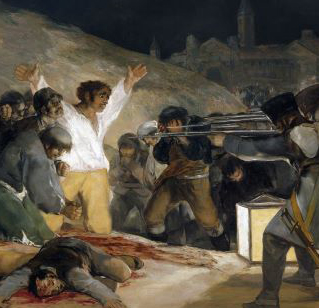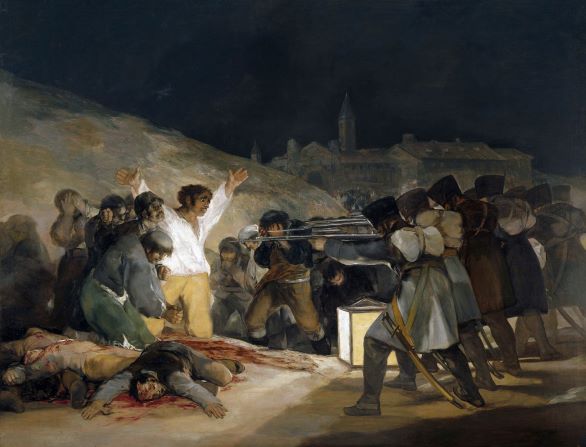
Goya and Manet
One of the great contributions that Manet made to the development of the art of the last 150 years is to promote the idea that art is about art, and not about anything else. He did this not by abandoning subject matter, as succeeding generations would, but by treating it in such a way that it lost its common meaning and was left only with the meaning generated by its internal relationships. This becomes particularly poignant when he makes the point by reinterpreting the work of an earlier artist. His favorite source, as a lover of Spanish culture, was the work of Goya, which he reinterpreted on at least three occasions. Of the three, Manets reinterpretation of Goya’s “Execution: The Third of May” is by far the most layered and poignant.


One of the things Manet seems to have loved about spanish art was its extensive use of black as a color; certainly this was a staple of Goya’s palette. But what each artist does with the color is entirely different. For Goya, the use of black, and indeed the management of light and shadow through the work, is for maximum emotional effect. The theme deals with the rising of the people of Madrid against the Napoleonic occupation (dealt with in the pendant work “The 2nd of May”) and the bloody executions which followed. Despite his clear sympathy for the rebels, he does not deal with them as heroes, but rather as helpless victims caught up in something bigger than themselves. Even the central figure, flooded with light and posed as the crucified Christ, looks more like a cornered rat turning to face his tormentors than a hero nobly facing death for a cause. And the firing squad, swathed in shadow and hunched in malign intent, inspires terror in us as in their victims.
Manet’s “subject” is the execution of Maximilian, the unfortunate emperor of Mexico, a puppet of French colonial aspirations, and a story with great emotional possibilities, had Manet chosen to exploit them. But what is “shocking” about this work is the complete lack of emotional force. As we look at it it becomes clear that the artist, and thus by necessity the viewer, is looking at paint on a surface. Every attempt to care about the subject is frustrated by its handling. The puff of smoke from the firing squad hides the face of Maximilan, and effectively erases him as the focus of the work. The soldiers of the firing squad, far from being menacing, are nothing but toy soldiers, and the bright patterns of their uniforms set the tone for a pleasing interplay of light and dark across the surface, and become the focus for marvelous paint handling rather than emotional content.
Manet seems to be saying to us, as he does in so many of his works, “This is not a story, it is a painting. All the things that are infuriating you about it are beside the point, and show that you have not understood the true nature of art. Instead of trying to empathize with the characters, try to revel in the passages of paint”.